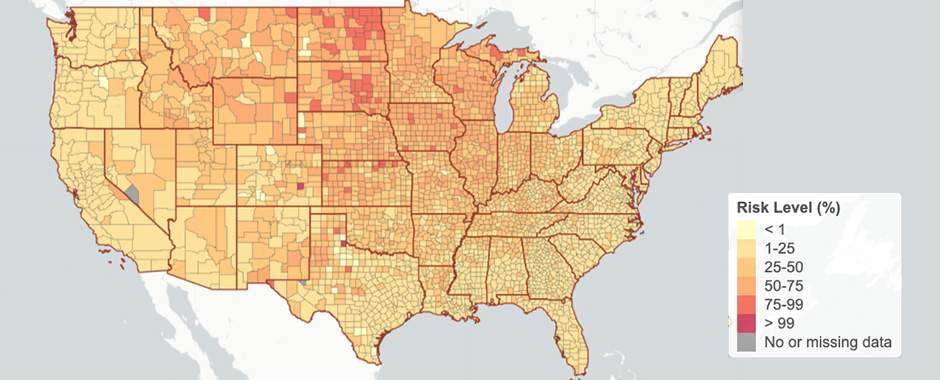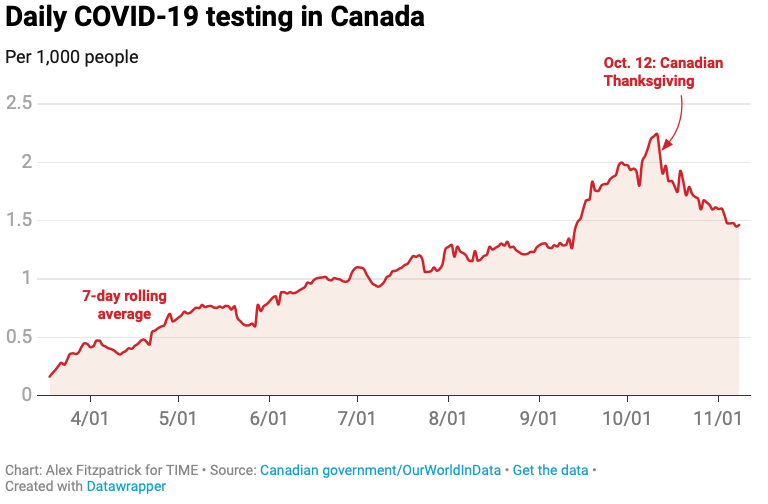Eduvation Blog
Monday, November 16, 2020 | Category: Eduvation Insider
The Once and Future Pandemic
It’s another Monday, which means we have a weekend’s worth of COVID19 news.
Mostly we’re seeing things unfold as I forecast months ago – in some ways it would be quicker to simply say “told you so.” But there are striking examples around the world of people and organizations behaving surprisingly well, and surprisingly badly. In general, I’ll stick to what strikes me as remarkable, and try to limit the pandemic news to Mondays and Thursdays.
Remember, digesting the daily news isn’t my ultimate objective, so much as offering thought-provoking and helpful strategic foresight. Nonetheless, the “Great Pandemic” of 2020-2022 will change much about higher ed and society, in the short term but also in more lasting ways. The severity, duration and psychological impacts of COVID19 will determine what happens over the coming decade.
So I think this sort of information is useful – but I welcome your feedback, as readers, to let me know if you agree!
COVID in Canada
Here in Canada, Ontario has seen 10 days in a row of 1,000+ cases, and now inevitably COVID19 deaths are spiking too, mostly in the GTA. As projections show Ontario will start hitting 6,500 new daily cases within weeks, premier Doug Ford says he “will not hesitate” to impose lockdowns – while he continues to hesitate, as he has done for months. “The time for asking nicely has passed,” says one infectious disease specialist. “We need to get out bylaw officers out.”
Alberta, too, is setting new COVID19 records, and Calgary faces what mayor Naheed Nenshi calls an “unbelievably bad” situation. About 8,000 school staff and students are in isolation in Calgary, and premier Jason Kenney himself is self-isolating until Nov 23.
As Manitoba reported record COVID19 deaths on Saturday, hundreds of covidiots turned out in Steinbach to protest PHO measures.
COVID on Campus
13 more cases have been announced on CdnPSE campuses since Friday…
Durham College reported on Friday another student tested positive for COVID19 at the Oshawa campus. (I think that makes 20 cases this fall.) DC
MacEwan U reports 12 students in the Theatre Arts program (about a third of the cohort) have tested positive for COVID19. The students last attended F2F class on Oct 23. “Upon first indication of a positive COVID19 diagnosis, the university immediately moved to online delivery of all classes in the Theatre Arts program.” F2F classes will apparently resume Nov 30. Global
COVID in the USA
Of course, nothing in Canada compares to what is happening south of the border…
American case counts have hit a third peak, with record increases in 14 states, a new daily high of 184,514 cases on Friday, and 1M new cases in the 10 days after Hallowe’en. The Midwest has been particularly hard-hit, setting new records in Iowa, Wyoming and Minnesota. Things might be fine if people would just “not do stupid things,” in the words of Los Angeles mayor Eric Garcetti – but sadly, we can’t seem to expect that.
As Notre Dame U’s “Fighting Irish” beat Clemson last weekend, “thousands of students leapt over brick walls… overwhelmed security guards and stormed the field.” There were 11,011 spectators admitted to the stadium, which the athletics director explained aligned with the “moral obligation” of returning students to campus. (NDU president John Jenkins has little credibility on campus masking protocols when he famously appeared unmasked at the White House, and then contracted COVID19 himself.)
“I find this so ethically troubling. Notre Dame set the students up exactly for what they’re not supposed to do. Father Jenkins is clearly complicit in setting our students up for failure.” – Eileen Hunt Botting, Political Sci prof, Notre Dame U
A cruise ship departed Barbados with 119 aboard, but was forced to return to port within days because of an unspecified number of positive COVID19 tests. Royal Caribbean has nonetheless found some 10,000 volunteers for mock cruises to rehearse COVID19 protocols.
A Texas appeals court overturned a stay-at-home order in El Paso County, where tent hospitals and morgue trucks are rapidly filling, finding in favour of the governor and restaurant owners. Scott Atlas, the White House coronavirus advisor who is pro-herd immunity, maintains that “lockdowns kill people” and “destroy families.” (Meanwhile >130 Secret Service officers are in quarantine because of Trump campaign travel or exposure at the White House.) Mississippi governor Tate Reeves has declared his state “will not participate” in any nationwide lockdowns. Meanwhile Alabama’s chief PHO has been the target of death threats, and is wearing a bulletproof vest for public briefings.
Although the CDC is urging Thanksgiving dinners with “immediate household family only,” almost 40% of Americans plan to attend a gathering of >10 people. (2 Georgia Tech profs have built a useful tool to map risk by gathering size, for every county in the US.) It’s a little sobering that Time magazine is using Canada as a cautionary tale of post-Thanksgiving disaster. (We saw considerable growth in COVID19 cases, despite much more limited testing capacity.) Sadly, it looks like the US could see another 13M cases before inauguration day on Jan 20, more than doubling its current 10.7M.
“At the same time the lockdown measures should have been bringing things down, it was actually Thanksgiving pushing those numbers back up.” – Matthew Oughton, Asst Prof of Medicine, McGill U
COVID in Europe
Denial is not unique to the USA…
Sputnik V
In Russia, the denial of reality is also healthier than the country’s citizens. New cases hit a record 21,983 on Friday as Moscow imposed curfews on restaurants and bars, and moved PSE study online. Global health experts are suspicious of Russian claims that its “Sputnik V” vaccine is “92% effective,” based on just 20 infections in a “so-called Phase III trial” – coming just 2 days and 2% higher than the Pfizer/BioNTech announcement.
But some European countries are ambitious about testing…
Operation Moonshot
Britain has purchased 200M COVID19 rapid tests, and hopes to buy enough to test every UK resident everymonth. (Testing only those who are symptomatic misses 20-40% of infected people, who are asymptomatic.) A pilot project is attempting to test all 600,000 residents in the Liverpool region, and if all goes well it will roll out nationwide in January. Residents would carry a certificate on their phone permitting them to enter sporting events, bars or restaurants.
Slovakia was the first country in the world to establish nationwide testing of everyone over age 10. In the first weekend, 3.6M of a potential 3.8M people were tested.
Austria plans to test its entire population (8.8M) for COVID19 antibodies, after its 3-week national lockdown lifts on Dec 6, to “bring about the safest possible Christmas.”
“My urgent request: Do not meet anybody. Every social contact is one too many.” – Sebastian Kurz, Chancellor, Austria
Pandemic Prognosis
I’ve made the case in COVID101 that, while we will see a first-generation vaccine roll out in mid-2021, it may take a year or two to overcome manufacturing hurdles, distribution challenges, vaccine hesitancy, and special-needs groups to immunize the entire planet. Here are a few more recent statements to help frame the “return to normal” post-pandemic…
Harvard WFH thru June
Harvard U has announced that most faculty and staff will continue to work remotely through Jun 30 2021. “The pandemic will continue to affect our lives, and how we do our work, for some time to come.” Harvard Magazine
Vaccine by April
Anthony Fauci predicts that the Pfizer vaccine could be generally available to those Americans who want it by the end of April 2021, after priority doses for frontline healthcare workers and at-risk individuals, school teachers and school children. Herd immunity, however, will require overcoming vaccine hesitancy, and “may take well into the second or third quarters.” CNN
Pandemic in 2021
The course of the COVID19 pandemic next year hinges on the precautions adopted by the general public, and on the efficacy and availability of vaccines and treatments. But several epidemiologists argue that “life as we know it” will continue to be disrupted even after a vaccine is widely available. It will take months to give the entire country 2 doses. Anti-vaxxers and the vaccine-hesitant will be slow to comply. Vaccine trials for children aged 12-18 are running about 6 months behind those for adults, and there have been none for children under 12. Face masks, physical distancing, avoiding large gatherings or concerts will continue long after the vaccine. Huffington Post
“We need to figure out how to vaccinate kids because I don’t know that this virus is going to disappear just by vaccinating adults or by protecting the elderly and most vulnerable. I don’t think we’ve figured out how to do schools and I don’t know that vaccination among the adults alone will be sufficient to solve the problem.” – Michael Levy, Assoc Prof of Epidemiology, uPennsylvania
Campus Next Fall
Some infectious disease experts caution that the COVID19 vaccine still needs to complete testing to determine its impact on asymptomatic transmission, since only symptomatic participants in the Pfizer trial were tested. (It might be suppressing symptoms without preventing infection or infectiousness.) If the vaccine is truly 90% effective, then the pandemic would be brought under control once 60-80% of the population has been immunized. College students will not be a high priority group, and have demonstrated greater vaccine hesitancy, so it could take months before that threshold of herd immunity is reached on campus. (Most vaccine trials have been on adults age 18+, so it remains to be tested on younger students, who will also require parental permission.) It is still unknown whether colleges can immunize their students en masse, or will have the necessary freezers to store the vaccine. Things may start returning to normal in Fall 2021, but masks, testing, physical distancing, and enhanced cleaning protocols will stay in place “for the foreseeable future.” Insider Higher Ed
Post-Pandemic Rebound
After the 1918 Spanish Flu pandemic, relaxing precautions such as mask-wearing and social distancing resulted in a resurgence of other diseases, such as measles. Infectious disease researchers at Princeton warn that our efforts to contain COVID19 have also suppressed other respiratory diseases. “While this reduction in cases could be interpreted as a positive side effect of COVID19 prevention, the reality is much more complex… Susceptibility to these other diseases… could increase… resulting in large outbreaks when they begin circulating again.” The implications for influenza depend on vaccines, but researchers are particularly concerned about a major resurgence of Respiratory Syncytial Virus in winter 2021-22, and potentially other endemic diseases. Princeton
#ICYMI
Forget the Code
The Lambda School, an online coding academy with a distinctive income share agreement instead of tuition, launched a powerful 1-min commercial last week, apparently focused on minority, working parents looking to upgrade their skills. “This isn’t about the code… Really, it’s about getting out of your own way. Fighting that little voice that says ‘You can’t do this. You don’t belong.’” It seems to acknowledge the pandemic a bit, too: “You’re still here. Tired, tattered, battered and scared, but still fighting.” Great performances, cinematography and writing. Nice. YouTube
Hope your week gets off to a great start! Be safe and stay well,
All contents copyright © 2014 Eduvation Inc. All rights reserved.







